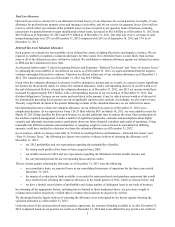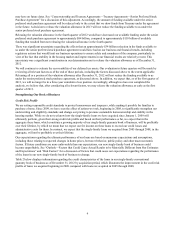Fannie Mae 2012 Annual Report Download - page 19
Download and view the complete annual report
Please find page 19 of the 2012 Fannie Mae annual report below. You can navigate through the pages in the report by either clicking on the pages listed below, or by using the keyword search tool below to find specific information within the annual report.
14
than $250 billion in mortgage assets by the end of 2018. As we reduce the size of our mortgage portfolio, our revenues
generated by our mortgage portfolio assets will also decrease. If current market conditions continue, we expect that these
declines in our revenues will generally be offset by rising guaranty fee revenue received for managing the credit risk on loans
underlying Fannie Mae MBS held by third parties. We recognize almost all of our guaranty fee revenue in net interest income
in our consolidated statements of operations and comprehensive income (loss). We expect that, in a number of years,
guaranty fees will become the primary source of our revenues as a result of both the shrinking of our portfolio and the impact
of guaranty fee increases in 2011 and 2012. Any future increases in guaranty fees will likely only further increase our
guaranty fee revenue. The amount of our guaranty fee revenue in future periods will be impacted by many factors,
including adjustments to guaranty fee pricing we may make in the future, which we discuss in “Legislative and Regulatory
Developments—Changes to Our Single-Family Guaranty Fee Pricing and Revenue.”
As our effective guaranty fee revenue increases in future periods, we expect our credit losses will decrease as a result of the
higher credit quality of our new book of business, the decrease in our legacy book, and anticipated lower severity at the time
of charge-off.
Uncertainty Regarding our Future Status. There is significant uncertainty regarding the future of our company, including
how long the company will continue to be in its current form, the extent of our role in the market, what form we will have,
and what ownership interest, if any, our current common and preferred stockholders will hold in us after the conservatorship
is terminated. We expect this uncertainty to continue.
In 2011, Treasury and the Department of Housing and Urban Development (“HUD”) released a report to Congress on
reforming America’s housing finance market. The report states that the Administration will work with FHFA to determine the
best way to responsibly wind down both Fannie Mae and Freddie Mac. The report emphasizes the importance of providing
the necessary financial support to Fannie Mae and Freddie Mac during the transition period. We cannot predict the prospects
for the enactment, timing or content of legislative proposals regarding long-term reform of the GSEs. See “Legislative and
Regulatory Developments” for discussions of recent legislative reform of the financial services industry and proposals for
GSE reform that could affect our business. See “Risk Factors” for a discussion of the risks to our business relating to the
uncertain future of our company.
Factors that Could Cause Actual Results to be Materially Different from Our Estimates and Expectations. We present a
number of estimates and expectations in this executive summary, including estimates and expectations regarding our future
financial results and profitability, our future dividend payments to Treasury, our future revenues from guaranty fees, the
profitability and performance of single-family loans we have acquired, our future acquisitions, our future REO inventory, our
future delinquency, default and severity rates, our future credit losses and loss reserves, future housing market conditions,
performance and volumes and future home prices. These estimates and expectations are forward-looking statements based on
our current assumptions regarding numerous factors, especially future home prices and the future performance of our loans.
Our future estimates of our performance, as well as the actual amounts, may differ materially from our current estimates and
expectations as a result of: the timing and level of, as well as regional variation in, home price changes; changes in interest
rates, unemployment rates and other macroeconomic and housing market variables; our future guaranty fee pricing; our
future serious delinquency rates; future legislative or regulatory requirements that have a significant impact on our business,
such as a requirement that we implement a principal forgiveness program; future updates to our models relating to our loss
reserves, including the assumptions used by these models; future changes to accounting policies relating to our loss reserves;
significant changes in modification and foreclosure activity; changes in borrower behavior, such as an increasing number of
underwater borrowers who strategically default on their mortgage loan; the effectiveness of our loss mitigation strategies,
management of our REO inventory and pursuit of contractual remedies; whether our counterparties meet their obligations in
full; changes in the fair value of our assets and liabilities; impairments of our assets; changes in generally accepted
accounting principles (“GAAP”); credit availability; natural and other disasters and many other factors, including those
discussed in “Forward-Looking Statements,” “Risk Factors” and elsewhere in this report. Due to the large size of our
guaranty book of business, even small changes in these factors could have a significant impact on our financial results for a
particular period.
RESIDENTIAL MORTGAGE MARKET
The U.S. Residential Mortgage Market
We conduct business in the U.S. residential mortgage market and the global securities market. According to the Federal
Reserve, total U.S. residential mortgage debt outstanding, which includes $9.9 trillion of single-family mortgage debt
outstanding, was estimated to be approximately $10.8 trillion as of December 31, 2012. After increasing every quarter since
























